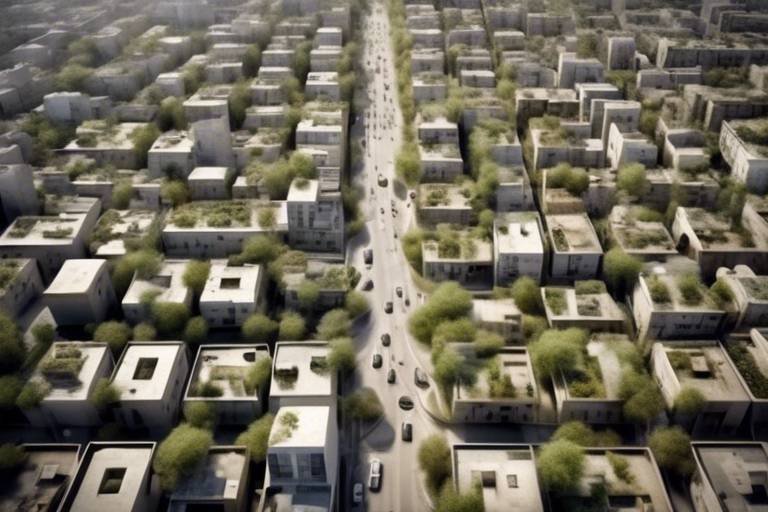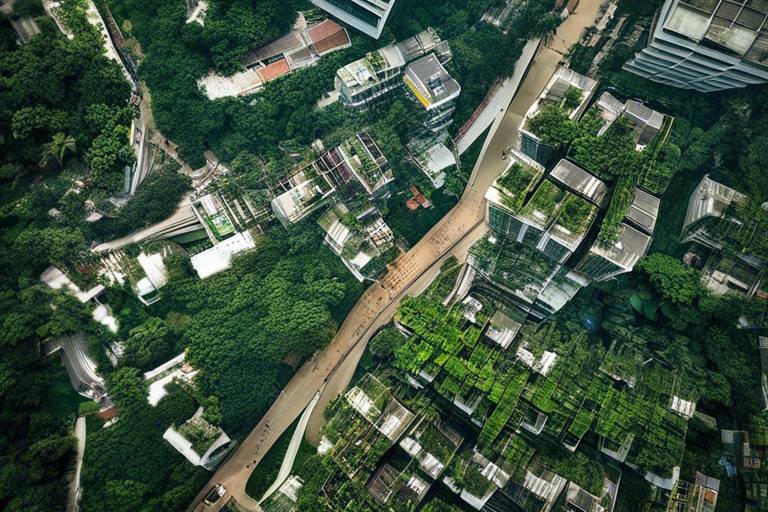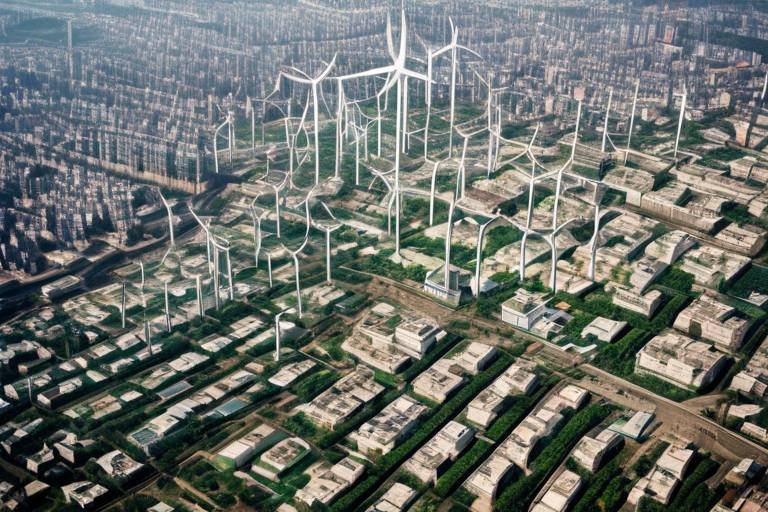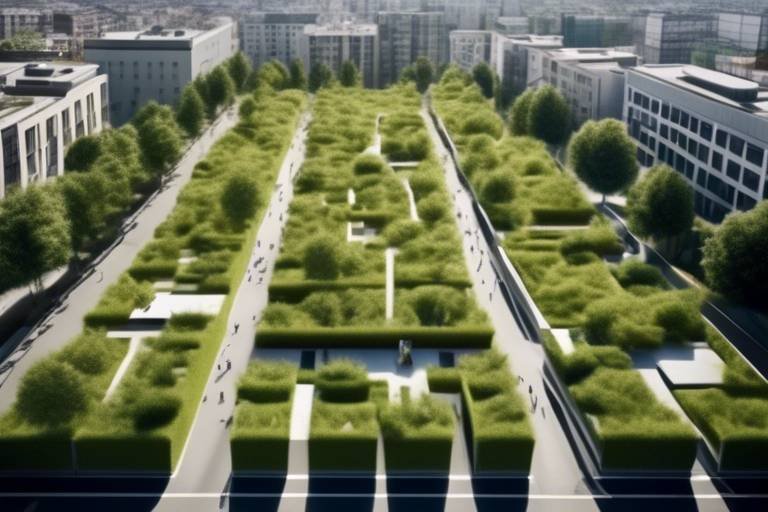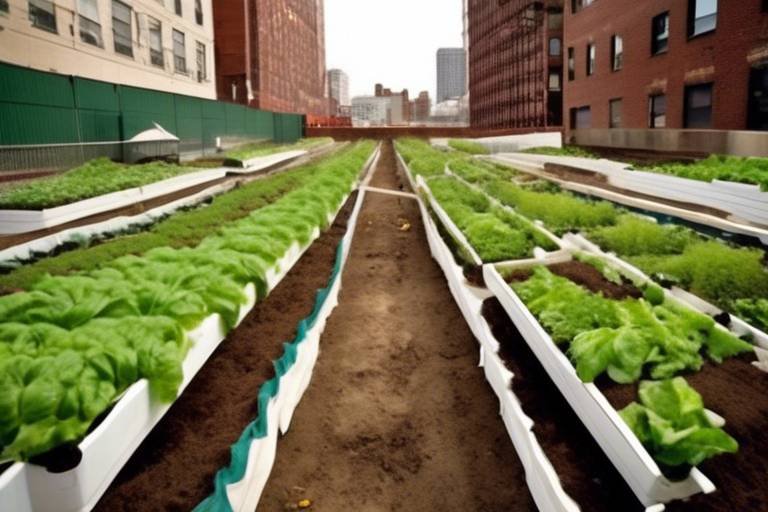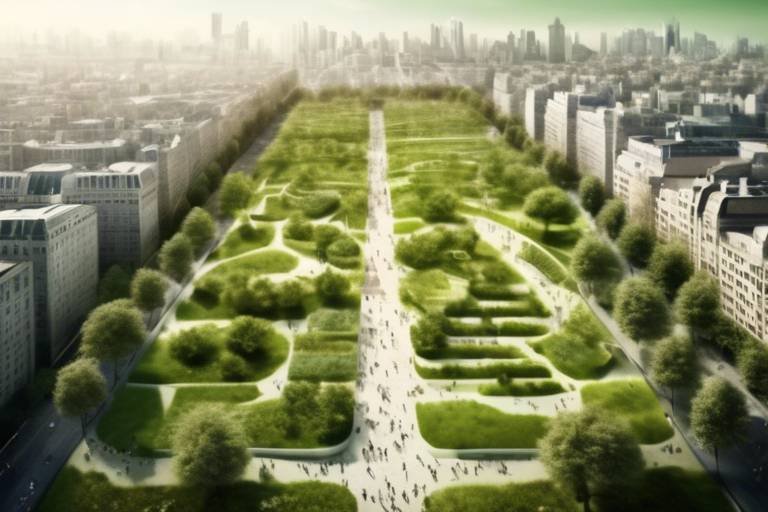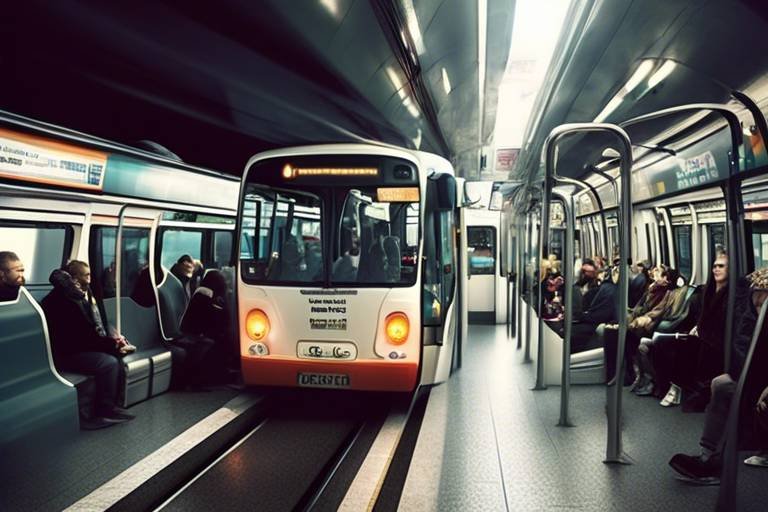Revitalizing Urban Areas through Sustainable Practices
Urban areas around the globe are facing unprecedented challenges, from overcrowding and pollution to economic decline and climate change. As cities continue to grow, the need for sustainable practices has never been more critical. Revitalizing urban areas through sustainability not only enhances the livability of these spaces but also contributes to a healthier planet. Imagine a city where green parks replace concrete jungles, where clean energy powers homes and businesses, and where communities thrive together. This vision is not just a dream; it's a necessity that can be achieved through innovative strategies and practices.
In this article, we will explore various approaches to urban revitalization that focus on sustainability. We will delve into the importance of sustainable urban development, the role of green infrastructure, community engagement, renewable energy integration, smart transportation systems, waste management innovations, urban agriculture initiatives, and effective policy frameworks. Each of these elements plays a crucial role in creating vibrant urban areas that are not only functional but also enjoyable for residents and visitors alike.
As we navigate through these topics, consider this: What does a sustainable city look like to you? Is it a bustling marketplace filled with local produce, or perhaps a serene park where families gather? The answer may vary, but the underlying principle remains the same—sustainability is key to revitalizing our urban landscapes.
Understanding the significance of sustainable urban development is crucial for addressing environmental challenges, improving quality of life, and creating resilient communities that can adapt to changing conditions. Sustainable urban development is not just a trend; it’s a fundamental shift in how we perceive and interact with our cities. It emphasizes the need for balance between economic growth, social equity, and environmental stewardship. By prioritizing sustainability, cities can reduce their carbon footprints, enhance public health, and create spaces that foster community engagement.
Moreover, sustainable urban development encourages the use of resources in a way that meets the needs of the present without compromising the ability of future generations to meet their own needs. This concept is particularly important in urban areas, where the concentration of population and activity can lead to significant environmental impacts. By embracing sustainable practices, cities can mitigate these impacts and create a more livable environment for all residents.
Implementing green infrastructure, such as parks, green roofs, and permeable pavements, can significantly improve urban ecosystems, reduce heat islands, and enhance biodiversity in densely populated areas. Think of green infrastructure as the lungs of a city—just as our lungs filter air and provide oxygen, these green spaces filter pollutants and provide essential habitats for wildlife. For instance, parks not only offer recreational spaces for residents but also serve as vital ecosystems that support various species.
Here are some key benefits of green infrastructure:
- Improved Air Quality: Plants absorb carbon dioxide and release oxygen, contributing to cleaner air.
- Stormwater Management: Permeable pavements and green roofs help manage rainwater, reducing flooding.
- Enhanced Property Values: Proximity to green spaces often increases property values and attracts new residents.
Active community involvement is essential for successful urban revitalization projects, fostering a sense of ownership and ensuring that developments meet the needs and desires of local residents. When communities are engaged in the planning process, they are more likely to support initiatives that reflect their values and priorities. This engagement can take many forms, including public meetings, workshops, and online surveys, allowing residents to voice their opinions and contribute ideas.
Furthermore, community engagement builds social capital, which is vital for the long-term success of urban projects. When people feel connected to their neighborhoods, they are more likely to participate in local events, volunteer for initiatives, and advocate for sustainable practices. This sense of belonging transforms urban areas into vibrant, inclusive spaces where everyone can thrive.
Integrating renewable energy sources, such as solar and wind, into urban planning not only reduces carbon footprints but also promotes energy independence and economic growth within urban settings. Imagine a city powered entirely by renewable energy—where solar panels adorn rooftops and wind turbines grace the skyline. This vision is becoming a reality in many urban areas as they transition to cleaner energy sources.
Renewable energy integration offers several advantages:
- Reduced Energy Costs: By harnessing natural resources, cities can lower their energy bills.
- Job Creation: The renewable energy sector creates jobs in installation, maintenance, and innovation.
- Climate Resilience: Cities that invest in renewable energy are better equipped to handle climate-related challenges.
1. What is sustainable urban development? Sustainable urban development refers to the practice of creating urban environments that are economically, socially, and environmentally sustainable. 2. How can communities get involved in urban revitalization? Communities can participate by attending public meetings, engaging in workshops, and providing feedback on proposed projects. 3. What are some examples of green infrastructure? Examples include parks, green roofs, rain gardens, and permeable pavements. 4. How does renewable energy benefit urban areas? Renewable energy reduces carbon emissions, lowers energy costs, and creates jobs, contributing to a more sustainable economy. 5. Why is community engagement important in urban planning? Community engagement ensures that developments meet the needs of residents, fostering a sense of ownership and support for projects.

Importance of Sustainable Urban Development
Understanding the significance of sustainable urban development is crucial for addressing environmental challenges that cities face today. As urban populations continue to grow, the strain on resources intensifies, leading to issues such as pollution, congestion, and inadequate housing. By embracing sustainable practices, cities can create vibrant, livable spaces that not only benefit the environment but also enhance the quality of life for their residents. Imagine a city where clean air, green parks, and efficient public transport are the norms rather than the exceptions. That’s the dream of sustainable urban development!
One of the key aspects of sustainable urban development is its ability to improve quality of life. When cities implement sustainable practices, they often see a reduction in pollution levels, which directly correlates with better health outcomes for residents. Cleaner air and water lead to fewer respiratory issues, lower healthcare costs, and an overall healthier population. Furthermore, sustainable urban areas tend to incorporate more green spaces, which not only beautify the city but also provide residents with recreational opportunities and a refuge from the hustle and bustle of urban life.
Additionally, sustainable urban development fosters economic viability. By investing in green technologies and infrastructure, cities can create jobs in emerging sectors such as renewable energy, waste management, and sustainable agriculture. These jobs are not just a temporary fix; they contribute to long-term economic stability by attracting businesses that prioritize sustainability. In fact, cities that adopt sustainable practices often see an increase in property values as well, as more people desire to live in areas that prioritize health and environmental stewardship.
Moreover, the concept of resilience is at the heart of sustainable urban development. As climate change continues to pose significant threats to urban areas—such as rising sea levels, extreme weather events, and resource scarcity—cities must adapt to these challenges. Sustainable practices equip urban areas with the tools necessary to withstand and recover from such adversities. For instance, cities that invest in green infrastructure can better manage stormwater, reducing the risk of flooding and protecting vital ecosystems.
In summary, the importance of sustainable urban development cannot be overstated. It is a multifaceted approach that addresses environmental, social, and economic issues, creating a holistic framework for thriving urban communities. By prioritizing sustainability, cities can not only enhance the livability and resilience of their environments but also ensure a better quality of life for current and future generations. Are we ready to embrace this change? The time is now!
- What is sustainable urban development? Sustainable urban development refers to practices that promote economic, social, and environmental sustainability in urban areas.
- Why is sustainable urban development important? It addresses environmental challenges, enhances quality of life, and creates resilient communities.
- How can cities implement sustainable practices? Through green infrastructure, community engagement, renewable energy, and smart transportation systems.
- What are the benefits of sustainable urban development? Improved health, economic growth, enhanced resilience, and better quality of life.

Green Infrastructure Solutions
When we think about urban environments, we often picture concrete jungles with little room for nature. However, are revolutionizing how we view and interact with our cities. These innovative practices not only enhance the aesthetic appeal of urban areas but also provide numerous environmental benefits. Imagine walking through a city where lush parks, vibrant green roofs, and permeable pavements coexist with bustling streets. This is not just a dream; it's becoming a reality in many cities around the world.
One of the most significant advantages of green infrastructure is its ability to combat the urban heat island effect. Cities tend to be warmer than surrounding areas due to human activities and the prevalence of heat-absorbing materials like asphalt and concrete. By integrating more green spaces, we can lower temperatures, improve air quality, and create a more pleasant environment for residents and visitors alike. For instance, urban parks can reduce temperatures by several degrees, providing a cool refuge during hot summer days.
Moreover, green roofs are becoming increasingly popular in urban planning. These living roofs not only provide insulation for buildings but also absorb rainwater, reducing runoff and the risk of flooding. By creating a natural barrier, green roofs help to filter pollutants and improve air quality. Imagine a city where every building has a garden on its roof, contributing to biodiversity and reducing the overall carbon footprint. It's a win-win situation!
Permeable pavements are another exciting green infrastructure solution. Unlike traditional concrete surfaces that prevent water from soaking into the ground, permeable pavements allow rainwater to filter through, replenishing groundwater supplies and reducing stormwater runoff. This can significantly alleviate pressure on urban drainage systems, especially during heavy rainfall. Just think about the impact of transforming parking lots and sidewalks into surfaces that contribute positively to the ecosystem!
Incorporating these green solutions into urban planning requires collaboration among city planners, architects, and the community. It's essential to engage local residents in the decision-making process to ensure that the developments reflect their needs and desires. When communities are involved, the projects are more likely to succeed and foster a sense of ownership among residents.
To summarize, green infrastructure solutions are not merely an aesthetic enhancement; they are a crucial component of sustainable urban development. By embracing these practices, cities can improve livability, enhance biodiversity, and create a healthier environment for all. The future of urban living lies in our ability to harmonize nature with our concrete landscapes, and the time to act is now!
- What is green infrastructure? Green infrastructure refers to a network of natural and semi-natural features that provide environmental, social, and economic benefits in urban areas.
- How does green infrastructure help with flooding? Green infrastructure, such as permeable pavements and green roofs, allows water to infiltrate the ground, reducing runoff and the risk of flooding during heavy rains.
- Can green infrastructure improve air quality? Yes, green spaces can help filter pollutants from the air, improve overall air quality, and provide a healthier environment for residents.
- How can communities get involved in green infrastructure projects? Communities can participate by attending public meetings, providing feedback on proposed projects, and volunteering for local initiatives aimed at enhancing green spaces.

Community Engagement in Urban Revitalization
When it comes to revitalizing urban areas, one of the most powerful tools in our toolkit is community engagement. Imagine a neighborhood where every resident feels a sense of ownership, pride, and responsibility towards their surroundings. This is not just a dream; it’s a reality that can be achieved through active participation and collaboration among community members. Engaging the community in urban revitalization efforts transforms mundane projects into vibrant initiatives that reflect the desires and needs of the people who live there.
Community engagement is essential for several reasons. First and foremost, it fosters a sense of belonging. When residents are involved in the decision-making process, they are more likely to take pride in their neighborhood and contribute positively to its development. This sense of ownership can lead to increased volunteerism, where individuals dedicate their time and resources to improve their community. Just think about it: when you have a stake in something, you’re more inclined to care for it. It’s like tending to your garden; the more effort you put in, the more you reap the benefits.
Moreover, engaging the community ensures that revitalization projects are tailored to meet the actual needs of the residents. Often, urban planners and developers may have grand visions, but without input from those who live in the area, these plans can miss the mark. For example, a community might prefer a new park over a parking lot, or they might prioritize affordable housing over luxury condos. By facilitating open dialogues through town hall meetings, surveys, and workshops, planners can gather valuable insights that shape more effective and relevant projects.
One effective method of fostering community engagement is through collaborative workshops. These workshops can serve as a platform for brainstorming ideas, discussing challenges, and developing solutions. Not only do they empower residents to voice their opinions, but they also help build a sense of community as people come together to work towards a common goal. Imagine a group of neighbors gathered around a table, sketching out plans for a new community garden or a mural that reflects their shared history. It’s these moments of collaboration that can spark creativity and innovation in urban spaces.
Another innovative approach is utilizing technology to engage residents. Social media platforms, mobile apps, and online forums can facilitate discussions and gather feedback from a broader audience. This is especially important in today’s digital age, where many people may not be able to attend in-person meetings due to time constraints. By creating virtual spaces for discussion, cities can ensure that every voice is heard, regardless of physical presence.
To illustrate the impact of community engagement in urban revitalization, let’s take a look at a few successful case studies:
| City | Project | Outcome |
|---|---|---|
| Detroit, MI | Neighborhood Planning Initiative | Increased community involvement led to the creation of over 30 new parks and green spaces. |
| San Francisco, CA | Community-Led Housing Development | Affordable housing units built with input from local residents, ensuring they meet the community's needs. |
| New York, NY | Street Revitalization Project | Transformed streets into pedestrian-friendly areas through extensive community feedback, resulting in reduced traffic and increased foot traffic to local businesses. |
In conclusion, community engagement is not just a checkbox to tick off in the urban revitalization process; it is the very heartbeat of successful projects. By actively involving residents, cities can create spaces that are not only functional but also foster a sense of community, identity, and pride. As we look towards the future of urban development, let’s remember that the best solutions often come from those who know their neighborhoods best—the people who live there.
- What is community engagement? Community engagement refers to the process of involving local residents in decision-making and planning for their neighborhoods.
- Why is community engagement important in urban revitalization? It ensures that projects reflect the needs and desires of residents, fostering a sense of ownership and pride.
- How can technology facilitate community engagement? Technology can provide platforms for discussion, feedback, and collaboration, reaching a wider audience.
- What are some successful examples of community engagement? Cities like Detroit, San Francisco, and New York have successfully involved residents in various revitalization projects, leading to positive outcomes.

Renewable Energy Integration
In today's rapidly evolving world, the integration of renewable energy sources into urban planning is not just a trend—it's a necessity. Cities are facing unprecedented challenges, from climate change to energy insecurity, and the need for sustainable solutions has never been more pressing. Imagine a city where the sun not only brightens your day but also powers your home. This is the future we can create through the strategic incorporation of renewable energy.
One of the most significant benefits of integrating renewable energy is the reduction of carbon footprints. By harnessing the power of the sun, wind, and other renewable resources, urban areas can drastically cut greenhouse gas emissions. For instance, cities that invest in solar panels can generate their own electricity, decreasing reliance on fossil fuels. This shift not only helps the environment but also promotes energy independence. No longer will cities be at the mercy of fluctuating oil prices or geopolitical tensions; they can produce their own clean energy.
However, the integration of renewable energy goes beyond just installing solar panels on rooftops. It involves a comprehensive approach that includes:
- Strategic Planning: Urban planners must incorporate renewable energy solutions into the city’s infrastructure from the ground up. This means considering energy-efficient buildings, smart grids, and sustainable public transportation systems.
- Community Involvement: Engaging local residents in discussions about energy needs and solutions fosters a sense of ownership and ensures that the initiatives meet the community's needs.
- Innovative Financing: Cities can explore various financing options, including public-private partnerships, to fund renewable energy projects without overburdening taxpayers.
Moreover, the economic benefits of renewable energy integration cannot be overlooked. By investing in clean energy, cities can create new jobs in installation, maintenance, and technology development. According to a recent report, the renewable energy sector is projected to create millions of jobs worldwide in the coming years. This means that by transitioning to renewable sources, cities not only contribute to a healthier planet but also stimulate local economies.
To illustrate the impact of renewable energy integration, consider the following table showcasing the potential benefits:
| Benefit | Description |
|---|---|
| Environmental Impact | Reduces greenhouse gas emissions and pollution, improving air quality. |
| Economic Growth | Creates jobs and stimulates local economies through new industries. |
| Energy Security | Decreases reliance on imported fuels and enhances energy independence. |
| Community Resilience | Empowers communities to be self-sufficient and adapt to energy crises. |
In conclusion, the integration of renewable energy into urban planning is a multifaceted approach that promises to transform our cities into sustainable hubs of innovation and resilience. It’s not just about adopting new technologies; it’s about reimagining how we live, work, and interact with our environment. As we move forward, let’s embrace this challenge and work together to create cities that are not only livable but also thriving ecosystems of sustainability.
- What are the main types of renewable energy? The main types include solar, wind, hydroelectric, geothermal, and biomass energy.
- How does renewable energy benefit urban areas? It reduces carbon emissions, enhances energy independence, creates jobs, and fosters economic growth.
- What role do communities play in renewable energy integration? Community involvement ensures that energy solutions meet local needs and fosters a sense of ownership.
- Can renewable energy sources fully power a city? While challenging, many cities have successfully transitioned to using a significant percentage of renewable energy.

Smart Transportation Systems
In today's fast-paced world, the need for efficient and sustainable transportation systems is more critical than ever. leverage technology to enhance mobility, reduce congestion, and minimize environmental impact in urban areas. Imagine a city where traffic jams are a thing of the past, where commuters can seamlessly transition from one mode of transport to another, and where air quality is significantly improved. This is not just a dream; it's a reality being crafted through innovative solutions in urban planning.
One of the cornerstones of smart transportation is the integration of public transit systems. By enhancing the accessibility and reliability of buses, trams, and trains, cities can encourage residents to opt for public transportation over personal vehicles. This shift not only reduces the number of cars on the road but also lowers greenhouse gas emissions. For instance, cities like Barcelona have implemented extensive public transport networks that connect seamlessly, making it easier for residents to choose public options.
Moreover, the implementation of smart traffic management systems plays a pivotal role in optimizing traffic flow. These systems utilize real-time data to manage traffic signals, monitor congestion, and provide drivers with up-to-date information about road conditions. For example, cities like Los Angeles are using adaptive traffic signals that adjust based on current traffic patterns, leading to smoother flows and reduced wait times. The result? A significant decrease in fuel consumption and emissions.
Another exciting aspect of smart transportation is the promotion of active transportation options, such as biking and walking. Cities are increasingly investing in bike lanes and pedestrian-friendly infrastructure, creating a more inviting environment for those who prefer to travel on foot or by bike. This not only fosters a healthier lifestyle but also contributes to a reduction in vehicular traffic. For instance, Copenhagen has become a model for bike-friendly cities, boasting extensive cycling paths that encourage residents to ditch their cars.
Furthermore, the rise of mobility-as-a-service (MaaS) platforms is revolutionizing urban transportation. These platforms integrate various transport services into a single accessible interface, allowing users to plan, book, and pay for multiple modes of transport in one go. Whether it’s a combination of public transit, ride-sharing, or bike rentals, MaaS simplifies travel and promotes the use of sustainable options. Cities like Helsinki are leading the way in implementing these systems, providing residents with convenient access to diverse transportation methods.
However, the success of smart transportation systems hinges on robust community engagement. Urban planners must involve residents in the decision-making process to ensure that the systems developed meet the needs of the community. This can be achieved through public forums, surveys, and pilot programs that allow residents to provide feedback on proposed changes. By fostering a sense of ownership and participation, cities can create transportation systems that truly reflect the desires and requirements of their inhabitants.
In conclusion, smart transportation systems are not just about technology; they are about creating a livable urban environment that prioritizes sustainability and accessibility. By investing in public transit, traffic management, active transportation, and community engagement, cities can transform their transportation networks into efficient, eco-friendly systems. As we look toward the future, it’s clear that the integration of smart transportation solutions will be a game-changer for urban areas around the globe.
- What are smart transportation systems? Smart transportation systems are integrated solutions that use technology to improve the efficiency and sustainability of urban transport networks.
- How do smart transportation systems reduce congestion? By utilizing real-time data and adaptive traffic management, these systems can optimize traffic flow and minimize delays.
- What role does community engagement play? Involving the community in planning and decision-making ensures that transportation solutions meet the actual needs of residents.
- Can smart transportation systems improve air quality? Yes, by reducing the number of vehicles on the road and promoting public transport, smart systems can lead to lower emissions and better air quality.

Waste Management Innovations
In today's rapidly urbanizing world, effective waste management has become a cornerstone of sustainable city living. The sheer volume of waste generated in urban areas poses a significant challenge, but innovative solutions are emerging to tackle this pressing issue head-on. Imagine a city where waste is not just discarded but transformed into valuable resources. This is not just a dream; it's a reality being shaped by cutting-edge waste management innovations.
One of the most exciting developments in waste management is the rise of recycling programs. These initiatives are designed to divert waste from landfills by encouraging residents to sort their trash at the source. Cities like San Francisco have set ambitious goals, aiming for a zero waste future. Through comprehensive recycling and composting programs, they have successfully diverted over 80% of their waste from landfills. This not only reduces the environmental impact but also fosters a culture of sustainability among residents.
Moreover, composting initiatives are gaining traction in urban areas. By converting organic waste into nutrient-rich compost, cities can significantly reduce the amount of waste sent to landfills while simultaneously enriching local soil. Community composting programs are popping up in neighborhoods, allowing residents to contribute to a greener urban landscape. For instance, cities like Seattle have implemented city-wide composting services, which have proven to be a game-changer in waste reduction.
Another innovative approach is the adoption of smart waste management technologies. These technologies utilize sensors and data analytics to optimize waste collection routes and schedules. Imagine garbage trucks that only collect waste when bins are full, reducing fuel consumption and emissions. This not only saves cities money but also minimizes the carbon footprint associated with waste collection. For example, cities like Barcelona are implementing smart bins equipped with sensors that notify waste management services when they need to be emptied.
Additionally, the concept of a circular economy plays a pivotal role in waste management innovations. This approach emphasizes the importance of reusing and recycling materials rather than disposing of them. By redesigning products and processes to minimize waste, cities can create a more sustainable and resilient urban environment. For instance, some cities are now encouraging businesses to adopt sustainable practices by offering incentives for reducing waste and utilizing recycled materials.
In summary, the landscape of waste management is evolving, driven by innovative practices that not only address the challenges of urban waste but also promote sustainability. By embracing recycling programs, composting initiatives, smart technologies, and circular economy principles, cities can pave the way for a cleaner, greener future. As we continue to innovate and adapt, the dream of a waste-free urban environment is becoming increasingly attainable.
- What are the main goals of waste management innovations? The primary goals include reducing landfill waste, promoting recycling and composting, and creating a more sustainable urban environment.
- How can residents participate in recycling programs? Residents can participate by sorting their waste into designated recycling bins and following local guidelines for recyclable materials.
- What is a circular economy? A circular economy is an economic system aimed at eliminating waste and the continual use of resources through recycling, reusing, and refurbishing.
- How do smart waste management technologies work? These technologies use sensors to monitor waste levels in bins and optimize collection routes, resulting in reduced emissions and costs.

Urban Agriculture Initiatives
Urban agriculture initiatives are transforming the way we think about food production in our cities. Imagine walking through your neighborhood and spotting a vibrant community garden bursting with fresh vegetables and herbs, or perhaps a rooftop farm that not only supplies local restaurants but also serves as a green oasis amidst the concrete jungle. These initiatives are not just about growing food; they are about cultivating community connections, enhancing food security, and promoting sustainable practices in urban environments.
One of the most compelling aspects of urban agriculture is its ability to utilize underused land. Vacant lots, rooftops, and even balconies can be transformed into productive spaces that contribute to the local food system. This is particularly important in densely populated areas where access to fresh produce can be limited. By converting these spaces into urban farms or community gardens, cities can reduce their reliance on food transported from far away, which often comes with a hefty carbon footprint.
Moreover, urban agriculture plays a significant role in enhancing food security. In a world where food deserts are prevalent, urban farms can provide fresh, nutritious food options to communities that need them the most. These initiatives not only make food more accessible but also educate residents about healthy eating habits and sustainable practices. For example, workshops on gardening techniques or cooking classes can empower individuals to make informed choices about their diets.
Additionally, urban agriculture fosters a sense of ownership and pride among community members. When residents participate in growing their own food, they develop a deeper connection to their environment and each other. This shared experience can lead to stronger community bonds and a greater commitment to maintaining these green spaces. As people work together to cultivate gardens, they also cultivate relationships, creating a more cohesive and resilient community.
To illustrate the impact of urban agriculture, consider the following table that highlights key benefits:
| Benefit | Description |
|---|---|
| Food Security | Increases access to fresh produce in urban areas, reducing reliance on distant food sources. |
| Environmental Impact | Promotes biodiversity, reduces urban heat, and contributes to cleaner air. |
| Community Engagement | Encourages social interaction and collaboration among residents. |
| Education | Provides opportunities for learning about sustainable practices and healthy eating. |
In addition to these benefits, urban agriculture can also stimulate local economies. By creating jobs related to farming, distribution, and sales, cities can encourage economic development while promoting sustainability. Farmers' markets, for instance, not only provide a venue for local growers to sell their produce but also attract visitors, thereby boosting local businesses.
As cities continue to grow and evolve, the integration of urban agriculture initiatives will be crucial in addressing various challenges, from food insecurity to environmental degradation. By embracing these practices, urban areas can become more sustainable and livable, turning concrete landscapes into lush, green spaces that benefit everyone.
- What is urban agriculture? Urban agriculture refers to the practice of cultivating, processing, and distributing food in or around urban areas.
- How does urban agriculture improve food security? It increases access to fresh produce, particularly in food deserts, and helps communities become more self-sufficient.
- Can anyone participate in urban agriculture? Yes! Many community gardens and urban farms welcome volunteers and provide resources for those interested in getting involved.
- What are some examples of urban agriculture? Examples include community gardens, rooftop farms, vertical gardens, and farmers' markets.

Policy Frameworks for Sustainable Cities
To truly revitalize urban areas and promote sustainability, effective policy frameworks are absolutely essential. These frameworks serve as the backbone of urban planning, guiding cities on how to implement sustainable practices while balancing economic, social, and environmental needs. Think of it as a roadmap that helps city planners navigate the complex landscape of urban development. Without clear policies, cities can easily fall into the trap of short-sighted decisions that prioritize immediate gains over long-term sustainability.
One of the key aspects of a robust policy framework is the integration of environmental regulations that encourage green building practices and energy efficiency. For instance, cities can adopt building codes that require new constructions to meet specific sustainability criteria, such as using renewable materials and incorporating energy-efficient technologies. This not only reduces the carbon footprint of buildings but also enhances the overall livability of urban spaces.
Moreover, incentives play a crucial role in promoting sustainable practices. Cities can offer tax breaks or grants to businesses and homeowners who invest in renewable energy systems, such as solar panels or wind turbines. This creates a win-win situation: residents save on energy costs while contributing to a cleaner environment. It’s like planting a seed that grows into a tree, providing shade and fruit for years to come.
Additionally, community engagement in the policymaking process is vital. When residents have a say in the development of their neighborhoods, they are more likely to support and participate in sustainability initiatives. Cities can hold public forums or workshops to gather input from the community, ensuring that policies reflect the needs and desires of those who live there. This not only fosters a sense of ownership but also builds trust between the government and the community.
To illustrate the importance of effective policy frameworks, consider the following table that highlights successful sustainable city policies from around the world:
| City | Policy | Impact |
|---|---|---|
| Copenhagen | Carbon Neutrality by 2025 | Significant reduction in greenhouse gas emissions |
| Curitiba | Integrated Public Transport System | Reduced traffic congestion and improved air quality |
| Singapore | Green Plan 2030 | Increased green spaces and biodiversity |
In conclusion, the establishment of comprehensive policy frameworks is not just a bureaucratic necessity; it is a powerful tool for transforming urban landscapes into sustainable havens. By prioritizing environmental regulations, offering incentives, and engaging the community, cities can create a solid foundation for a greener future. It’s about crafting a narrative where sustainability is not an afterthought but a fundamental part of urban life.
- What are the main components of a sustainable urban policy framework?
A sustainable urban policy framework typically includes environmental regulations, incentives for green practices, community engagement strategies, and long-term planning goals.
- How can community engagement improve sustainability efforts?
Community engagement ensures that policies reflect the needs and desires of residents, fostering support and participation in sustainability initiatives.
- What role do incentives play in promoting sustainable practices?
Incentives, such as tax breaks or grants, encourage businesses and homeowners to invest in renewable energy and sustainable practices, benefiting both the environment and the economy.
Frequently Asked Questions
- What is sustainable urban development?
Sustainable urban development refers to the practice of designing and managing urban areas in a way that meets the needs of the present without compromising the ability of future generations to meet their own needs. This involves balancing economic growth, environmental protection, and social equity to create livable, resilient communities.
- Why is green infrastructure important?
Green infrastructure plays a crucial role in urban sustainability by improving air and water quality, reducing urban heat, and enhancing biodiversity. It includes elements like parks, green roofs, and permeable pavements, which help cities manage stormwater, lower temperatures, and provide recreational spaces for residents.
- How can communities engage in urban revitalization?
Community engagement is vital for successful urban revitalization. Local residents can participate through public meetings, workshops, and surveys to express their needs and desires. This involvement fosters a sense of ownership and ensures that revitalization efforts align with the community’s vision and values.
- What are the benefits of integrating renewable energy in cities?
Integrating renewable energy sources like solar and wind into urban planning helps reduce carbon emissions, promotes energy independence, and can stimulate local economies. It also contributes to a more sustainable energy infrastructure, making cities more resilient to energy shortages and price fluctuations.
- What are smart transportation systems?
Smart transportation systems encompass a range of technologies and strategies aimed at improving urban mobility. This includes efficient public transit options, dedicated bike lanes, and pedestrian-friendly infrastructure, all designed to reduce traffic congestion, lower emissions, and enhance overall accessibility in urban areas.
- How can cities improve their waste management practices?
Cities can enhance waste management through innovative practices such as recycling programs, composting initiatives, and waste-to-energy technologies. These efforts not only minimize landfill waste but also promote a circular economy, where materials are reused and repurposed, reducing overall environmental impact.
- What role does urban agriculture play in cities?
Urban agriculture initiatives contribute to food security by providing fresh produce and creating community connections. By utilizing underused land, these initiatives promote sustainable practices and help cities become more self-sufficient in food production, while also enhancing green spaces and biodiversity.
- What policies support sustainable urban development?
Effective policy frameworks are essential for guiding sustainable urban development. These policies can include regulations that promote green building practices, incentives for renewable energy adoption, and support for community engagement in planning processes, all aimed at fostering long-term urban resilience and sustainability.

